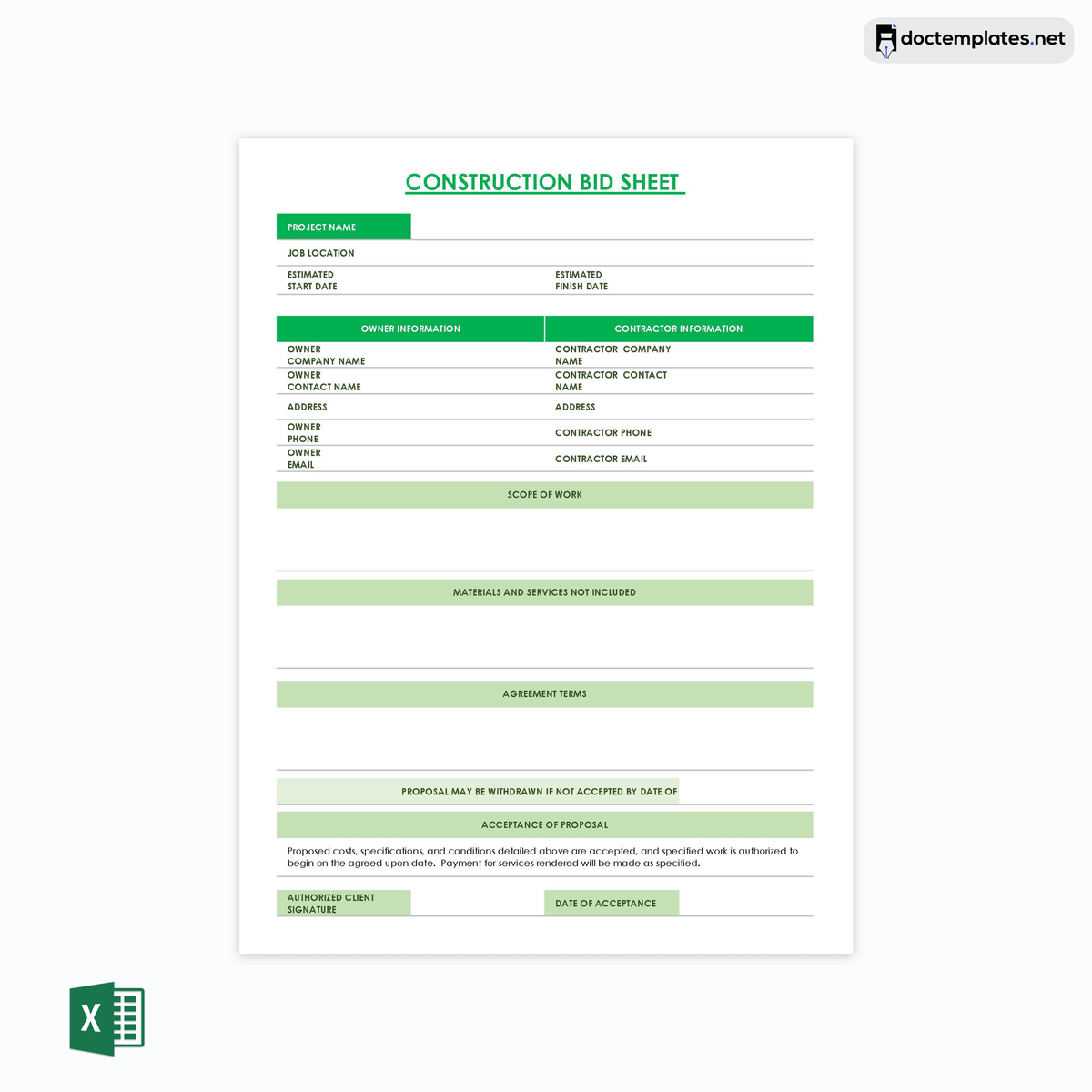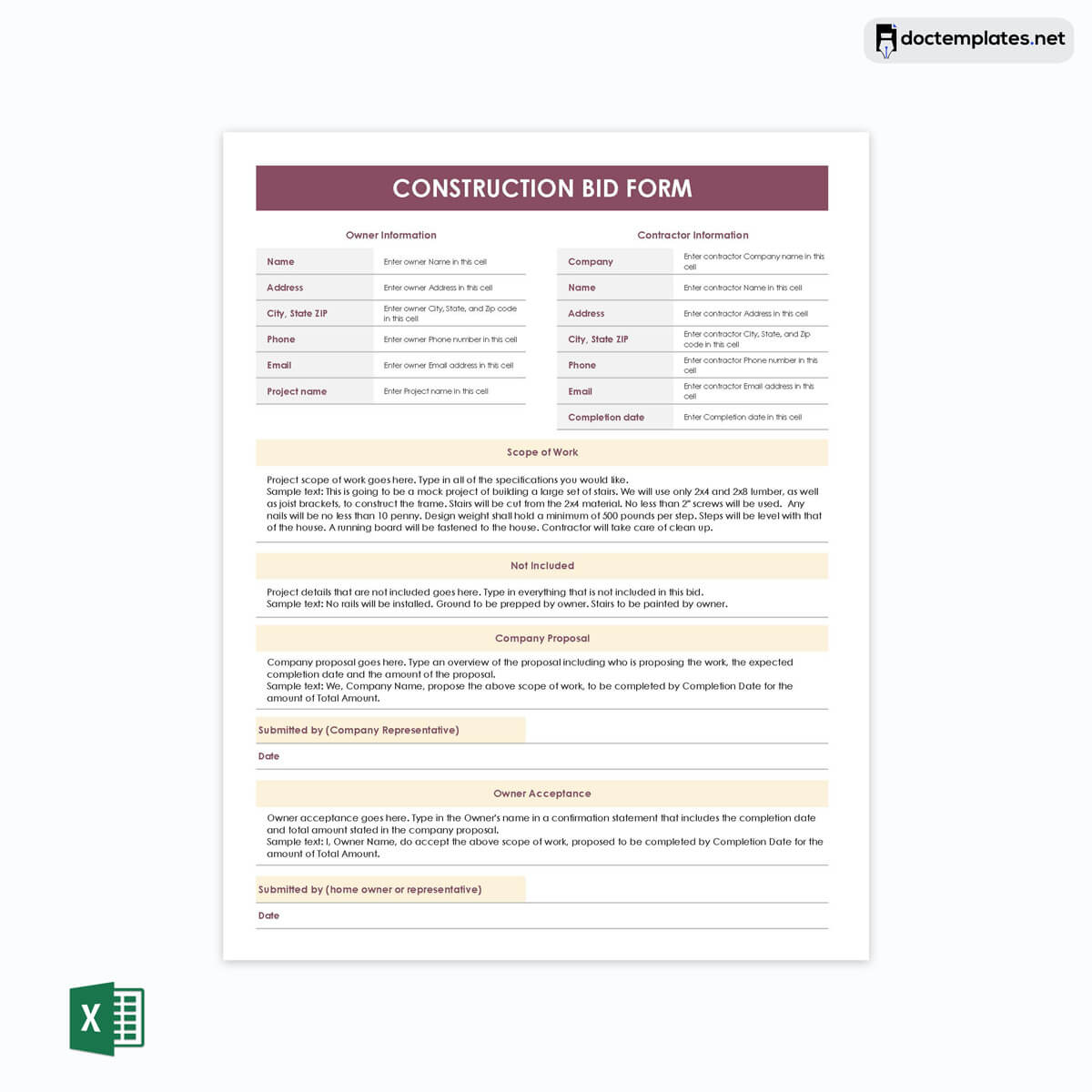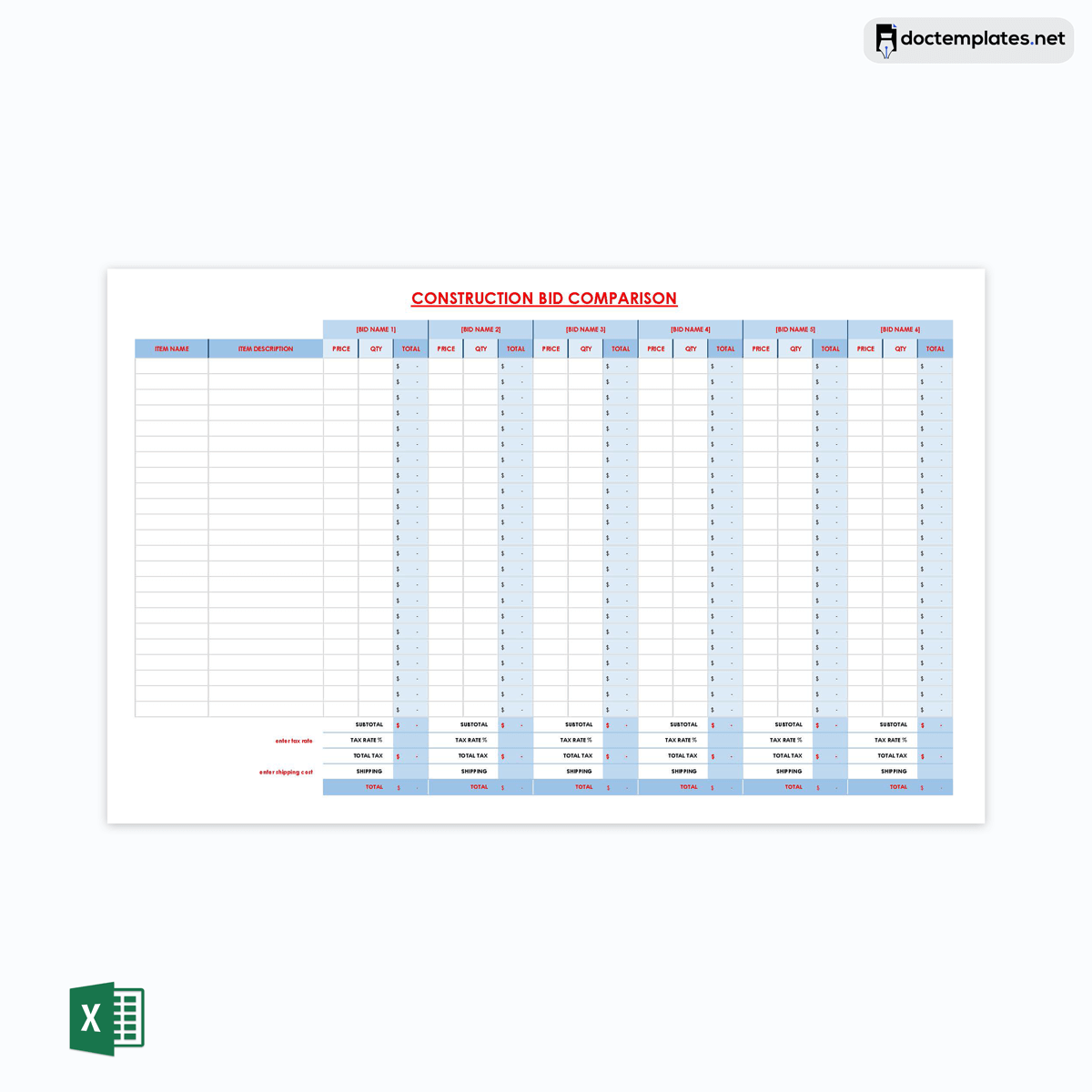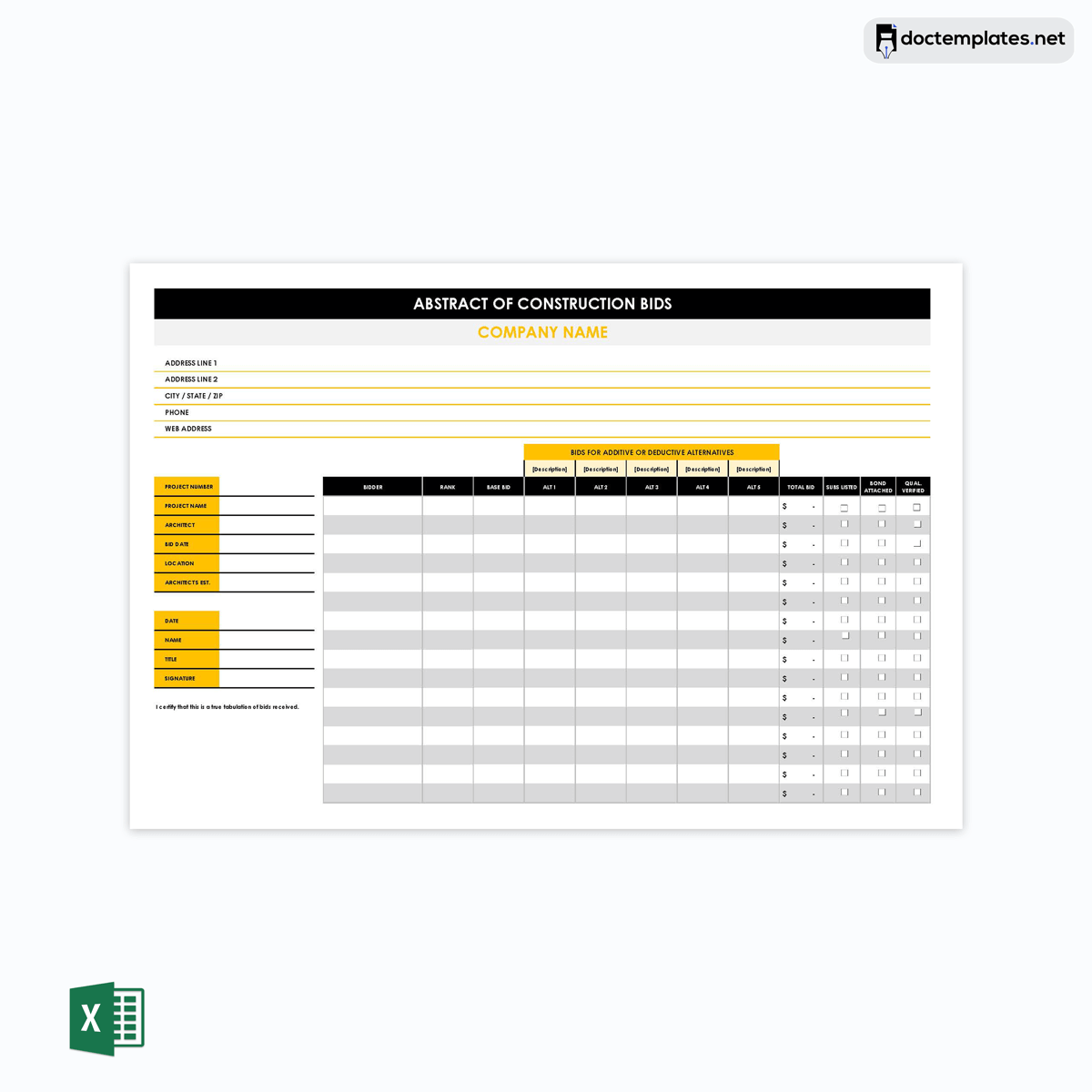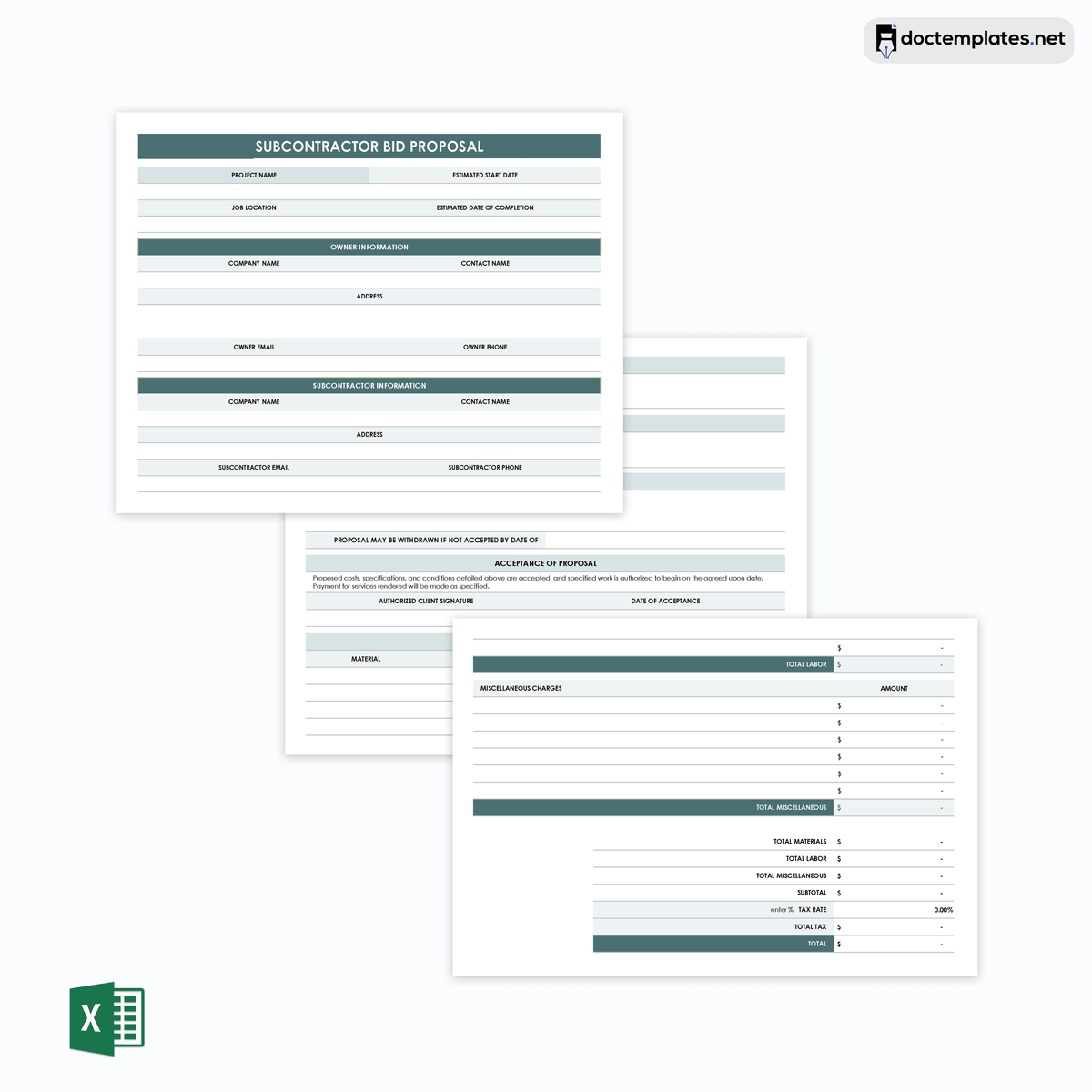Every construction project needs to go through a construction bidding process. That way, project owners responsible for building a construction project can contact contractors who provide different construction services.
Since most contractors win projects by bidding on them, it is crucial to conduct this step right. Nevertheless, contract bidding is not a skill contractors learn through their training or mentoring; rather, it is usually improved through experience. Therefore, the construction bidding process can be time-consuming and expensive, especially in the beginning.
Becoming a part of the construction bidding process requires you to submit a construction bid first. However, navigating the complex construction bidding process while expanding your customer base is a unique skill you must master.
So, whether you are a construction bid expert or writing a bid for the first time, you will undoubtedly learn much about construction bids in this article.
Construction Bid Templates
As you can probably tell from the information above, crafting a construction bid from scratch will require plenty of time and effort. Days can pass between the moment you gather the necessary information and the bid completion. However, not everyone has enough time to write a construction bid.
In that case, a construction bid template saves the project owner’s time and effort. We have come up with a template designed specifically for construction bidding purposes, so all you have to do is download the free template and fill it in with the required information.
What is Construction Bidding?
The construction bidding process is a vital part of every project for client companies and contractors. The process revolves around contractors submitting a tender for a particular construction project. Clients then choose the offer they like the most and draft a contract for collaboration on a construction project.
Since the primary goal of the construction bid is to help employers connect with contractors to bring construction projects to realization, most contractors get a job in construction by bidding on various construction projects.
Bidders must estimate the realistic costs of the project using construction plans, blueprints, and material quantity to secure the job. This means the tender, also known as the bid, is a unique proposal that enables companies to participate in a project. It contains all the details clients need to understand better what each contractor would accomplish on a project and at what price.
With construction tenders in mind, the bids are crafted according to the specifications of the contract and the bill of quantities. Then, the client chooses the most suitable bidder, after which the construction bidding process is complete.
Generally speaking, the construction bidding process consists of the following steps:
- Clients send bid invitations for construction to contractors
- Contractors receive bid invitations that include the scope of work, pre-qualification details, time of completion and penalty.
- Contractors download the tender and examine the project’s outline
- Contractors submit their bids on the construction project
- Clients select the contractor with the most competitive bid for the project
Note (bid vs. estimate): Before we proceed, it’s essential to clarify the difference between a bid and an estimate, often used interchangeably. An estimate refers to calculating internal costs that contractors face, such as the cost of materials and labor. A bid refers to the final price contractors charge their clients, which can also be called an offer. Therefore, a bid is usually higher than an estimate since it represents contractors’ profit on the job.
Construction Contracts and Bids Types
Both construction contracts and bids have several different types, which we will discuss below:
Construction contract
A construction contract format determines how the costs and profits are to be covered. It is a document that outlines the responsibilities of all parties involved in the construction project. As a result, the clients and contractors can ensure that they agree on the crucial features of a building project.
Since every construction project is unique, multiple contract types exist for different situations. Here are the three most commonly used contract types:
- Firm fixed price contract: One of the most widely used contract types is the firm fixed price contract, also known as the lump-sum contract. With this construction contract type, contractors accept one total sum for all works relating to a single project. In most cases, firm fixed-price contracts are used for projects with well-defined costs. They are also an excellent option for outlining incentives if a project is finished before the deadline or under budget.
- Cost plus contract: The basic rule of a cost-plus contract is that contractors report all the project-related costs as they appear. Then, the project owner covers all the expenses plus a contractor fee agreed upon before the project begins. The cost-plus contract is also known as cost plus a fixed percentage contract, cost plus with a guaranteed maximum price contract, and cost-plus fixed fee contract.
- Time and material contract: Time and material contract is a perfect choice when you cannot closely determine the project scope and when supervision is required. Namely, this contract involves paying for the purchased materials and an hourly rate for the contractor’s labor.
Construction bids
By selecting the proper construction bidding method, clients can improve the finished product’s quality, mitigate risks, and ensure the partnership benefits both parties.
There are four main types of construction bids:
- Open tendering: Open tendering is mainly used by private and government sector businesses. However, in this bid, anyone can submit an offer for an upcoming construction project.Since all applicants have an equal opportunity of winning, including new emerging contractors, open tendering is the most competitive bidding method. Nevertheless, open tenders require more time to evaluate all applications.
- Selective tendering: In selective tendering, only contractors who receive an invitation can submit a tender. In that case, contractors are chosen based on their ability to handle the project’s scope, size, and field of work. While clients who choose selective tendering can rest assured that their requirements will be met, this tendering method does not allow new contractors to enter the market.
- Negotiated tendering: Negotiated tendering involves only one contractor that is involved in the process. Namely, negotiated tenders are used by clients who want to negotiate with a single contractor from start to finish. These tenders are primarily used when clients want to extend the project scope and ensure clear communication between involved parties.
- Serial tendering: Serial tendering involves preparing tenders using a bill of quantities or schedule of works. Clients who choose serial tendering can then use the submitted rates to value the scope of work of similar projects. Therefore, serial tendering can be repeated for a fixed period.
Construction Bidding Process
The construction bidding process can be divided into several easily distinguished steps, as discussed below:
Bid solicitation
Bid solicitation is the initial step of the construction bidding process. At this stage, project owners send an Invitation for Bid (IFB) or a Request for Proposals (RFP), which can be quite a large and open invitation if a public project is in question.
Regardless of the document the project owner selects, the purpose of bid solicitation is to specify the contract type, project requirements, and delivery method. That way, the interested parties can get as much information as they need.
Subcontracting
Once the bid solicitation is finished, contractors can reassign certain work areas to their subcontractors. That means the general contractor can solicit bids from other subcontractors and award the winners with certain project parts. Nevertheless, general contractors usually wait until they win the bid before they subcontract.
It is essential to mention that subcontracting can also be done after the bid is awarded, but that depends on the construction bidding method.
Bid submission
In bid submission, contractors must represent their company best, which is why it should have a professional look. The bid submission contains the most critical information about a company, including the company’s past projects and management plans. This way, the clients can better understand the contractor’s completed tasks.
Moreover, the bid should also contain an estimated cost based on blueprints and the bill of quantities. Additionally, labor, overheads, materials, and equipment are other crucial elements included in the bid.
Regarding the price, bids with reasonable prices tend to win.
Bid selection
Bid selection is one of the more complex steps of the construction bidding process.
While government and public sector projects generally go with the lowest bidder to ensure no fraud or biases will affect the bid selection, private projects consider numerous other factors before deciding. As a result, each employer has different selection criteria for choosing a contractor that best fits their needs.
Contract formulation
Contract formulation is the last step of the construction bidding process. It includes the final negotiations regarding the project price and other discussable clauses of the contract. Finally, contact formulation is complete after the involved parties sign the legally binding document.
Project delivery
After the contract has been formulated and signed by both parties, the project delivery can begin according to the agreed-upon pricing and schedule.
Decisions of the construction bidding process
Since the construction bidding process contains various phases, making intelligent decisions in every phase of the process is crucial. Therefore, parties must decide on these crucial aspects of a construction bid.
Project delivery method
The project delivery method is responsible for construction bids’ performance and quality requirements. The four delivery systems help project owners create structures according to time and budget limits.
Design-bid-build or design tender (DBB)
In this project delivery method, contractors hire architects and designers independently. Once the architect completes the design, project owners solicit bids from contractors and execute the construction.
Construction management at risk (CMAR)
In the construction management at risk method, the design and construction are handled by different companies to reduce costs. The construction manager is part of the process from the very beginning and can even work with the architect.
Design-build (D-B)
The design-build method is created for projects where a single entity takes care of the design and construction. Therefore, one price covers two construction phases, and the design builders are responsible for all project aspects.
Integrated Project Delivery (IPD)
As one of the newer project delivery methods, the IPD method sets the project owner, contractor, and architect into a team, so they equally share the risk.
Procurement method
Continuing with the decision-making process, the next step is to decide on the procurement method used to obtain the required construction services. Construction procurement can be done in various ways.
Best value method (BVS)
In the BVS method, price and performance are the main factors when choosing the winning contractors. In this case, previous performance, management approach, and staff qualifications play a crucial role.
Negotiated method
No competitive bidding or advertising takes place in the negotiated procurement method. Instead, project owners negotiate with a potential contractor until the parties reach a mutual agreement.
Sole source or direct select
Only a single provider is used to fulfill all project requirements during the sole source procurement method. With that said, the sole source method is non-competitive.
Low bid
Unlike sole source, low bid is a competitive procurement method. Here, the lowest bidder wins the contract.
General contracting
In the case of general contracting, the project owner works with a general contractor responsible for building the construction project. Even though the general contractors execute all the work, they can hire subcontractors for specific parts of the work.
Construction management
If a project owner hires individual subcontractors for every part of construction work, such as electricity, plumbing, or masonry, they are working with the construction management method.
Contract model
As explained previously, the contract model defines how project owners must cover the cost and profit of contractors. The contract format is defined in every construction bidding process. The top contract models are:
Lump-sum contracts
Fixed-price or lump-sum contracts outline the total price for all the work that needs to be done. These contracts simplify bidding for contractors, which is why they are commonly used.
Cost plus fee contract model
The idea of a cost-plus-fee contract is to allow contractors to report costs to project owners as they occur. In addition to paying for the costs, project owners pay a fixed fee to the contractor.
GMP contract
The GMP contracts let contractors define a guaranteed maximum price for the project. Contractors must commit to the GMP amount even if the construction expenses exceed the estimates.
Time and material contract
In the time and material contract, contractors are paid hourly labor rates. Project owners also cover material costs and other expenses.
Unit Price contracts
The purpose of unit price contracts is to divide a whole project into several units. Then, contractors calculate the price of each unit instead of the entire project.
Do you know? Contrary to common belief, submitting the lowest bid does not guarantee your participation in the project. Project owners tend to go with mid-ranged price offers since they come at a much lower risk of being below the expected quality standard.
Information to Include
As one of the valuable documents, a construction bid has obligatory elements to include. These are:
Contact information
Every bid must contain the basic contact information of the construction company, including the name, address, phone number, email address, and a place for signatures. Without these pieces of information, a constructor cannot win a bid.
Scope
The construction bid should also include a brief overview of the project that says more about the project’s scope, services, work schedule, required materials, and other necessary features. Although the project’s scope is a crucial part of every contract, it should include all essential details, such as customer expectations, hired subcontractors, safety protocols, visitor rules, etc.
Existing conditions
In this section, the existing conditions of the site are explained in greater detail. From listing all the work that needs to be done to assigning tasks to people, the existing conditions section says more about the current conditions and expected outcomes.
Cost
Every construction bid needs a separate section strictly focused on the financial side of the project. This section estimates the price of individual phases and the project as a whole. It also deals with the potential costs that could appear if the project goes over the initial scope, so the customer is informed on time.
Terms of payment
The payment terms describe how the contractor will be paid for the work. Since most project owners will not pay the entire sum up front, the payment terms also decide the amount for the down payment. Moreover, the frequency and amount of installments are also explained here.
Relevant documentation
With the complexity and size of most construction projects in mind, the bid must contain all the other documentation that might be relevant. For instance, listing the sub-projects and their terms and conditions can be helpful.
Schedule
Lastly, every construction bid should include a detailed work schedule that determines the project’s start, finish, and milestones. Some bids also include the liability of certain events that might cause a delay, such as bad weather conditions, vacation days, sick leaves, delayed permits, etc.
Effective Practices
Some additional practices can further make the process of creating a construction bid easier and more effective:
Know the competition
Companies who know which other party is bidding on the same construction project can keep their eye on the competitors and follow their strategic moves. To better understand the competition, contractors can join various building trade groups and stay updated.
Bid early
Timing is crucial when it comes to bidding, and constructors should post their bids as early as possible. When a proposal is submitted early, the constructor has a higher chance of winning the bid. That is why constructors should follow construction bidding marketplaces and networks to find new opportunities.
Be judicious
It is not enough to post the proposal first to win a bid. Instead, organizations should be wise when crafting their proposals. From inspecting potential accomplishments to cultivating a specific niche, constructors must be judicious at every step.
Build relationships
Always strive toward building relationships with people you work with because that can affect future business decisions related to your company. After winning a bid, build a strong foundation and develop trust with your project partner.
Accentuate your strengths
Do not hold back when it is time to promote the qualities of your business. Instead, look at what the customer is searching for and show why your company is the best fit during the bidding process.
Leverage your expertise
Make the most of your expertise once you detect it. By leveraging your expertise, you will deliver high-quality projects in record time. If you are unsure what your area of expertise is, examine your previous projects and focus on the most successful ones, as they will help you find what you do best.
Understand the RFP
Understanding the RFPs is essential for successful bidding. Since RFPs contain the project’s terms and conditions, the scope of work and other crucial details, contractors who plan to submit a bid need to understand the project’s features completely.
Differentiate your brand
Your company needs to be professional and present to succeed in the construction bidding industry. Moreover, it’s always helpful if your brand differs from others and brings something unique, as this will ensure a competitive advantage.
Mistakes to Avoid
Mistakes will happen if you are a new company on the market or an experienced professional. Nevertheless, you can reduce the number of mistakes by avoiding some of the most common ones, as discussed below:
Improper review of the bid package
In a hurry to be among the first bid applicants, many businesses fail to review the bid package adequately and thus submit a bid that does not work well with the request. To avoid that, always examine what the clients are looking for before placing a bid.
Taking on projects with limited experience
Different projects are created for different levels of expertise. Even if you are ambitious as an emerging contractor, starting with projects you can accomplish is best. This way, you do not risk involving yourself in a project you do not have the resources or capacity to handle.
Insufficient visits to the site
As a contractor, you should pay enough visits to the site to obtain as much information as possible. You risk submitting a bid that does not contain precise details with insufficient site visits.
Inaccurate estimate
Lastly, inaccurate estimates can cause plenty of damage to the project. Whether you make inaccurate budget or work schedule estimates, any deviation from the original plan can cost you a lot.
Frequently Asked Questions
Is a construction bid an estimate?
A construction bid is not an estimate because these terms refer to two different things. A construction bid is the final offer contractors send to project owners. An estimate is the total amount of money required to complete the task.
How long should I spend on a proposal?
There is no universal answer on how long you need to work on a proposal because each proposal has different requirements. Therefore, the time required for a proposal largely depends on the project’s complexity.
Can I provide a credit letter as bid security?
In most cases, a credit letter is not used as bid security. That is because the law permits only the bonds found in construction contracts. As a result, you can use certified cashier’s checks and money orders.
How do I know the bid results?
You will be notified by email or phone when you win a construction bid provided in the solicitation.
Can I be reimbursed for my proposal preparation expenses?
Although the proposal preparation process comes with a few costly expenses, no contractor can be reimbursed for the costs.
